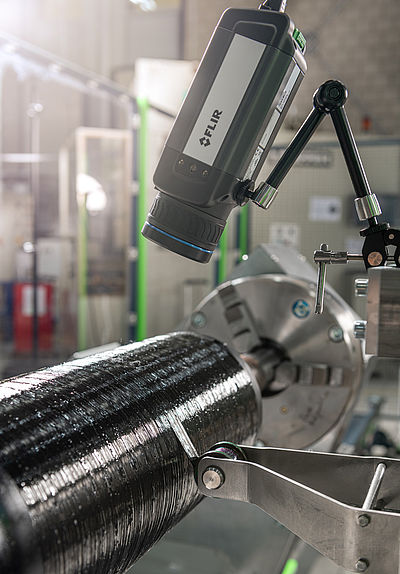Aachen, August 2020 – The Institute for Plastics Processing (IKV) in Industry and Craft at RWTH Aachen University has put into operation a new robot-based filament winding unit from the firm Hille Engineering. Especially for the Delfin consortium project, this will open up new possibilities for research into potential savings in the production by wet winding of Type 4 pressure tanks for fuel cell vehicles.
In the research project funded by the PMVI, a total of nine project partners (see picture) are carrying out research on the optimisation potential in the production of pressure tanks. They are looking at the entire value chain with the aim of increasing cost and material efficiency. In the project, a research team from IKV has assumed the task of studying the mechanical and thermal behaviour of the liner-boss-valve interface. In addition, the team is developing methods for the inline documentation of production errors in the wet winding process. Production faults in this context are taken to mean any deviations between the design of the tank by simulation and the actually manufactured tank. Because of the variety of possible production deviations, the research team will initially focus on documenting the fibre band geometry (fibre band width, fibre band orientation, fibre band thickness) and the positioning of the fibre band on the pressure tank. For this, they are evaluating the different optical techniques currently used for measuring.
Integration of optical measuring systems into the plant engineering
To obtain a reliable evaluation, integration of the measuring systems into the new plant engineering is of major importance. The robot-based filament winding unit works according to the principle of the moving mandrel, in which the winding mandrel moves back and forth on a linear axis in front of the thread eye. The thread eye, as part of the deposition head, is attached to a 6-axis KUKA KR 300 industrial robot. The deposition head contains an integrated winding mandrel for four fibre spools, a separate filament tension control for each filament, an impregnating unit and an additional band tension control. This enables precise fibre band deposition on the mandrel. The clamping length of the new machine is 300-3,000 mm, allowing the production of parts with a maximum weight of up to 300 kg (including mandrel). The diameter of the mandrel is limited here to 800 mm. Attainable winding velocities are up to 2 mm/s, depending on which mandrel is used. In addition to the wet winding process, the machine is also suitable for towpreg winding because of its high modularity in the deposition head.
The measuring technology for the fibre band geometry is integrated in the deposition head. Apart from the circumferential winding pattern, steep and flat helical winding patterns can also be examined. In order to be able to carry out initial tests quickly, suitable mountings for the optical measuring systems are currently being prepared.
Virtual reconstruction of the pressure tank
To determine the lay-up position, inline documentation of the fibre band alone is not adequate. To establish the position of the fibre band on the mandrel, the machine coordinates – and thus the lay-up position – are linked up to the measuring data, so that a spatially resolved allocation of the measuring data and thus a virtual reconstruction of the pressure tank is made possible. For this, the new winding unit features a rail-mounted PC with an SQL database, via which the position data and other relevant process parameters such as take-off speed, filament tension, knife gap and resin bath temperature are made available for the data evaluation.
The research project is being financed as part of the National Innovation Programme Hydrogen and Fuel Cell Technology (NIP) with funds from the Federal Ministry for Transport and Digital Infrastructure (BMVI) under funding code 03B10104D. The grant for the research project amounts to around EUR 7.5m. The programme coordinator of the NIP is NOW GmbH.
Contact for questions:
Nadine Magura, M.Sc.
+49 241 80-28330
nadine.magura@ikv.rwth-aachen.de



